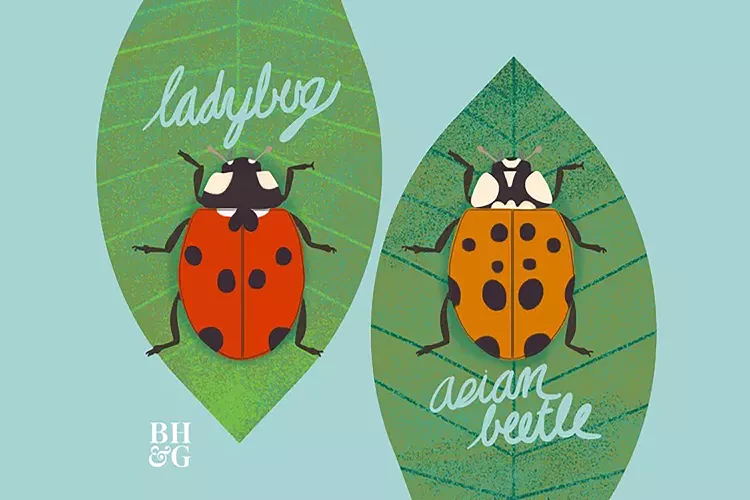You usually want to see a ladybug in your garden, but if you come across a yellow ladybug, it might not be what you think it is—it could be an invasive Asian lady beetle. Ladybugs are beneficial to your garden because they eat plant pests. Asian lady beetles also eat garden pests but have become a pest themselves, especially indoors during the cooler months.
It's common to spot Asian lady beetles congregating in huge numbers on houses and other buildings in the fall. They can bite and will release an unpleasant odor when disturbed. Unfortunately, these insects also have been pushing out native ladybugs. If you can tell the difference between the two insects, you might be able to stop an annoying problem before it starts.
Differences Between Ladybugs and Asian Lady Beetles
Asian lady beetles and ladybugs may belong to the same insect family and look very similar, but they are very different bugs. Many ladybug species are native to North America, but Asian lady beetles were introduced to the United States in the late 1910s. In the late 1970s and early 1980s, Asian lady beetles were intentionally released by the Department of Agriculture in several Southern states, as well as California, Pennsylvania, Connecticut, and Maryland, to control aphids and scale pests. Asian lady beetles can now be found across the continental United States and parts of Canada.
You can identify a ladybug by its markings and size. There are several species, with most sporting red shells and various numbers of black spots. Their heads tend to be black with small white “cheeks.”
Ladybugs are typically rounder and smaller than Asian lady beetles if you look at them side-by-side. Asian lady beetle shell color can range from light orange to bright red, so most will have a similar color to a ladybug. Asian lady beetles also have larger white “cheek” markings and have more white on their heads overall.
A sure way to distinguish between an Asian lady beetle and a ladybug is to look at the spot where the head meets the wings. If the bug in question has a black ‘M’ marking in that spot, that’s a telltale sign you’re dealing with an Asian lady beetle.
Another way you can be sure you're seeing Asian lady beetles rather than yellow ladybugs is if you're encountering them indoors. The Asian beetles tend to sneak into homes through cracks or holes when it gets cold outside. Ladybugs won’t do that.
Light attracts the Asian beetles, so they’ll often congregate on siding on the south side of a building, around door frames, and in windows. They bite by scraping the skin they land on, which feels like a pinprick but won’t cause any real damage. When threatened, Asian beetles release a stinky yellow substance that can stain surfaces and trigger allergic reactions. Ladybugs, on the other hand, do not congregate, bite, or release a stinky substance.
How to Control Asian Lady Beetles
The best way to keep Asian lady beetles out of your home is by sealing and patching potential entrance points. In addition, close up any gaps around windows, doors, and siding to minimize risk. The good news is that if they do get into your home, Asian lady beetles won't reproduce indoors and will make their exit in spring.
To safely get rid of Asian lady beetles in your home:
- Vacuum them up and empty the vacuum when you're done.
- Contain them in a sealed bag before tossing them into the trash so they can't crawl out.
- Avoid using pesticides because, besides exposing yourself to toxic chemicals, large numbers of dead beetles inside your walls may attract other pests.
- Sticky glue traps kept out of reach of small children and pets are a safe option for more minor infestations.
Outdoors, you can clear them off the areas where the beetles usually congregate with a broom or a strong spray of water from a pressure washer or hose. Then scrub down the area with soapy water; the pests most likely won't return because the soap smell overpowers the pheromones that attract more beetles to the location.




















